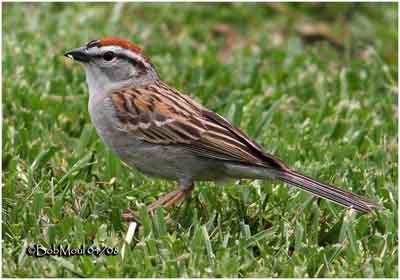
Chipping Sparrow
Spizella passerina
Passeriforme Order – Passerellidae Family
BIOMETRICS:
Length : 12-14 cm
Wingspan : 19-21 cm
Weight : 11-15 g
LONGEVITY: Up to 9 years
DESCRIPTION:
Chipping Sparrow breeding adult has bright chestnut crown, white conspicuous eyebrow, and fine black line from bill, through eye, to ear. Cheeks and nape are grey. It has grey rump and two white wing bars. Tail is long and notched.
Fr: Bruant familier
All : Schwirrammer
Esp : Chimbito Común
Ital : Passero cinguettante
Nd : Musboomgors
Sd : Tjippsparv
Photographs by Bob Moul
His website: Nature Photography
Photographs by Tom Grey
His website : Tom Grey's Bird Pictures
Text by Nicole Bouglouan
Sources:
FIELD GUIDE TO THE BIRDS OF NORTH AMERICA - National Geographic Society - ISBN: 0792274512
A GUIDE TO THE BIRDS OF MEXICO AND NORTHERN CENTRAL AMERICA by Steve N. G. Howell, Sophie Webb - Oxford University Press - ISBN: 0198540124
BIRDS OF THE GREAT BASIN – by Fred A. Ryser - Univ of Nevada Pr -ISBN: 0874170796
All About Birds (Cornell Lab of Ornithology)
Bird Web (Seattle Audubon Society)
What Bird-The ultimate Bird Guide (Mitchell Waite)
Wikipedia (Wikipedia, The Free Encyclopedia)

Winter adult has darker cheeks and black streaked crown. Underparts are whitish in all plumages.
Eyes are black. Conical and pointed bill is blackish. Legs and feet are pale brown.
Both sexes are similar, with female duller than male.
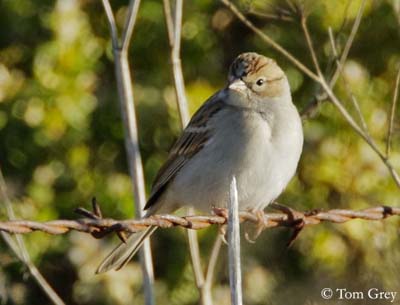
First winter has duller crown than adult and buff breast and sides.
Juvenile has streaked underparts and rump, and crown lacks chestnut colour.

VOICE: SOUNDS BY XENO-CANTO
Chipping Sparrow’s song is a rapid, dry trill on one pitch “chip”. Speed and length may vary. Call is given in flight or perched. It is a high, hard “seep” or “tsik”. Occasionally, Chipping Sparrow sings at night.

HABITAT:
Chipping Sparrow is adapted to human developments. It is found on lawns, grassy fields, orchards and parks. In natural habitat, they are common along woodlands edges, dry open woodlands, in pine-oak forests, and along river and lakes shores. It winters in similar habitat.
RANGE:
Chipping Sparrow breeds from eastern Alaska, through Canada, southwards to southern United States, and into Mexico and Central America.
It winters in Mexico, Central America and in southern United States.
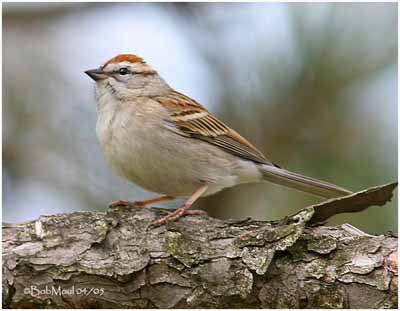
BEHAVIOUR:
Chipping Sparrow changes its plumage little by little during the year. It changes face and throat feathers up to six times per year. Body plumage is only replaced once or twice in the same period.
Chipping Sparrow is best known for its trilling song. It is very common in suburban areas.
It forages mainly on ground, and it frequents bird feeders. It forages in flocks, except during breeding season, in open areas near cover. Chipping Sparrow runs or hops, stopping to scratch with its feet, searching for food.

Chipping Sparrow is monogamous, but some males may have more than one mate. Both adults choose nest site together.
It is a migratory bird, often travelling in flocks.
FLIGHT:
Chipping Sparrow flies with rapid wing beats.
REPRODUCTION:
Chipping Sparrow’s nest is often close to human habitations, in gardens. Nest is situated on low limb, in trees or shrubs, and it is built by female.
Nest is cup-shaped and loosely built, with grasses, stems and rootlets. It is lined with hair. Chipping Sparrow prefers horse hair, but it may pluck hair from a sleeping dog.
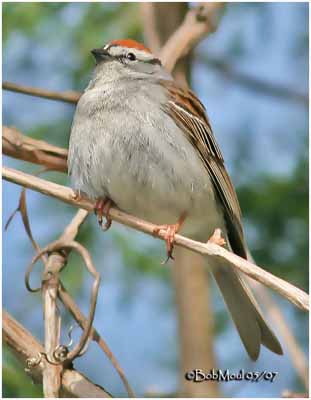
Female lays 3 to 4 pale blue eggs, spotted with brown. Incubation lasts about 11 to 14 days, by female, fed by male during this period. Chicks hatch altricial, and are fed by both parents for 9 to12 days, and young fledge at this time. Both adults feed them for about three weeks more.
This species produces one clutch per year, sometimes two.
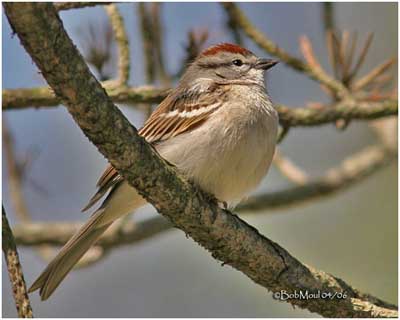
DIET:
Chipping Sparrow feeds on insects during breeding season, but after leaving the nest site, they feed in weedy fields and along woodland edges, with other family groups. They eat mainly insects and weed seeds.
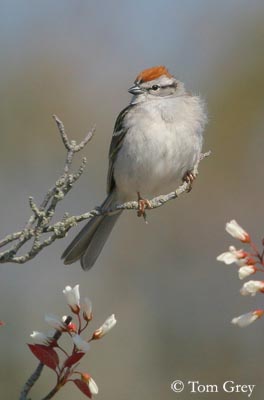
PROTECTION / THREATS / STATUS:
Chipping Sparrow is host of Brown-headed Cowbird. Competition with House Sparrows and House Finches, and habitat loss in some parts of their range, threat the populations of this species.
But Chipping Sparrows have benefited somewhat from human developments, and populations appear healthy.